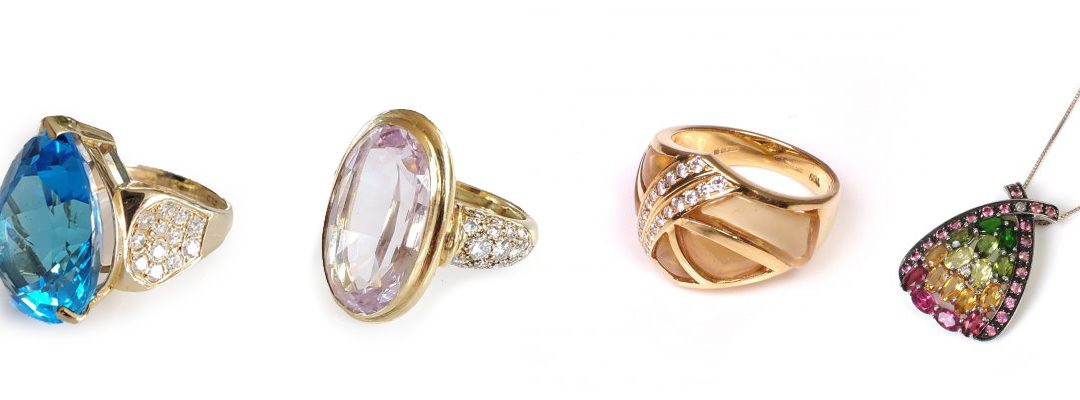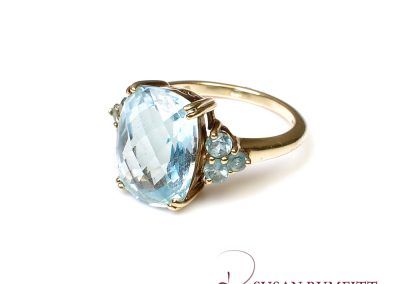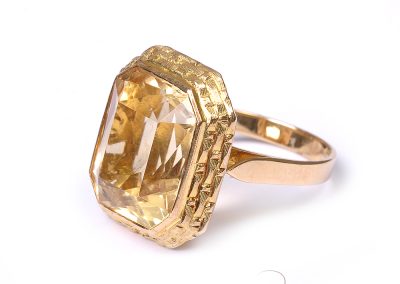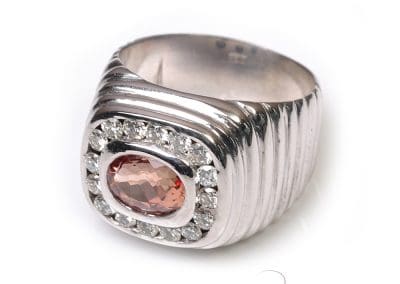Topaz and citrine are colourful gems that are totally unrelated but have often been mistaken for each other over the centuries. Citrine is the pale yellow to orange coloured variety of quartz while topaz has historically been associated with yellow and orange, although it is now most familiar as a blue gemstone.
Topaz can be colourless or come in a variety of stunning colours. This gemstone is said to symbolise love, strength and intelligence, and its blue form is a symbol of fidelity.
Citrine, meanwhile, is traditionally thought to promote vitality and energy in the wearer. With its name stemming from the Latin root for ‘lemon’, the sunny appearance of citrine is also said to bring happiness, health, positivity and prosperity. In Chinese feng shui philosophy, it is said to create wealth and abundance.
Being November’s birthstones, topaz and citrine include the zodiac signs Scorpio and Sagittarius.
Here we take a look at these two colourful gems that are November’s birthstones.
Topaz colours and history
The familiar topaz blue colour appears in various hues from sky blue, through Swiss blue, London blue, to cobalt blue. Although topaz does occur naturally as a pale blue, it is relatively rare.
The vivid blue colours are produced by a process invented in the 1970s where pure colourless topaz is irradiated and then heated. It’s worth noting that naturally blue topaz has also been irradiated and heated but by geological processes and not as intensively as artificially treated topaz, hence the much paler colour.
Although topaz does occur in a variety of mostly pale colours such as pale blue, greens, pinks and browns, it is the yellows and oranges with which it is historically associated; in fact some believe the name is derived from the Sanskrit word for fire. In the 16th century, before the diamond fields of Brazil were discovered, colourless topaz from the orient was often used as a more economical substitute for diamond.
While from the mid-18th century the Portuguese flooded the market with diamonds from Brazil, they were also quick to harvest Brazil’s other precious gemstones including topaz. It still served as a diamond substitute in less expensive silver jewellery but also became very fashionable in its own right and remained so for several centuries. Large, flat cut topaz in soft yellows, browns and pinks were worn as huge stomachers (jewellery worn on the front of a bodice), brooches and earrings.
1800s
By the beginning of the 1800s jewels were constructed of elaborate gold cannetille or filigree which enhance the warm tones of topaz. Although at this time ‘de jour’, or open back settings, were in use, many of the topazes continued to be mounted in closed back settings with coloured foil behind well into the 19th century. The enhanced the gems’ colour allowing for a more striking appearance. Large parures (sets of jewellery intended to be worn together) were fashionable at the time, often containing a rivière or large necklace, combs, bracelets, earrings and brooches. Foiling the topazes allowed jewellers to easily match the large amount of gem material which was required for the suite.
Imperial Topaz
Imperial topaz (also called precious topaz) ranges from yellow to yellowish-orange ‘sherry’ colours through pink-oranges to the most desirable orange-red to red colour. There are two theories about the origin of the name ‘imperial topaz’. One is that during the 19th century the pink to red topaz mined in the Ural Mountains was exclusively reserved for the Czars and so acquired the moniker, the other is that it was named in honour of the Brazilian imperial family who had access to the topaz reserves in Minas Gerais. The Brazilian Mino do Capão is currently the only source of imperial topaz, and although topaz crystals can be truly massive, the more saturated orange-red to reds are generally smaller and make up less than 1% of all gem quality topaz produced. Their rarity and beautiful colour allow fine quality imperial topaz to command in excess of $3,500/carat.
Meaning ‘the golden topaz’ this is currently the world’s biggest faceted gem (cut with a flat top, polished faces and a point at the bottom to reflect light and maximise brilliance). Housed in the Spanish Programa Royal Collection, it weighs in at 31,000 carats – that’s 6.2 kilos or 13.66lbs. Unbelievably, the cut gem is only 20% of the weight of the original rough crystal, the rest was lost to produce the intense yellow-brown colour and high clarity. The second and third largest faceted gems are also topaz, namely the American Golden Topaz (22,892.5 carats) and the Brazilian Princess (21,005 carats).
The Whitney Flame Topaz
At a comparatively small, but far more wearable, 48.86 carat the Whitney Flame Topaz with pure, saturated red colour and outstanding clarity is one of the rarest examples of topaz available.
The Russian Pink Topaz Suite
Currently owned by the Swedish royal family the demi-parure was given to Grand Duchess Maria Pavlovna of Russia by her mother on the birth of her first daughter in 1808. The suite was passed down the female line, moving with successive daughters as they married to Germany and then Sweden when Princess Victoria of Baden married the crown Prince of Sweden. On her death Victoria bequeathed the impressive set to a Swedish foundation so they would stay in Sweden, and they have since been extensively used by the subsequent two queens.
Pink topaz parures were also owned by Empress Marie-Louise and Princess Marie of Württemberg.
Citrine
Citrine is the pale yellow to orange coloured variety of quartz. Before modern gemmology it was not uncommon for all yellow stones to be called topaz, so when a second gemstone was added to each birthstone in the early 1900s, citrine was an obvious choice to accompany topaz. It was also a more affordable option.
Although not now commercially mined, citrine occurs in the highlands of Scotland where it adorned the hilts of Scottish warriors’ daggers. Queen Victoria’s love of all things Scottish was enthusiastically embraced by the populous and Scottish jewellery set with citrine was very fashionable during her early reign.
In particular a shade of brownish-yellow quartz, half way between citrine and smoky quartz and know as a Cairngorm after the mountain range where it occurs, was particularly prestigious. In fact, this same region also produces the rare form of natural pale blue topaz.
Citrine was also very popular during the Art Deco period, although at this time it was the stronger more vivid stones that were preferred. Many of the sirens of the big screen were seen in large and elaborate citrine pieces.
Topaz and citrine at Susan Rumfitt Fine Jewellery
At our gallery in Harrogate we offer topaz and citrine pieces for sale, including the gorgeous rings below (click on the picture to find out more):
Click here to browse our selection of topaz jewellery and here for citrine jewellery or book an appointment for a private viewing of our Gallery Collection.



